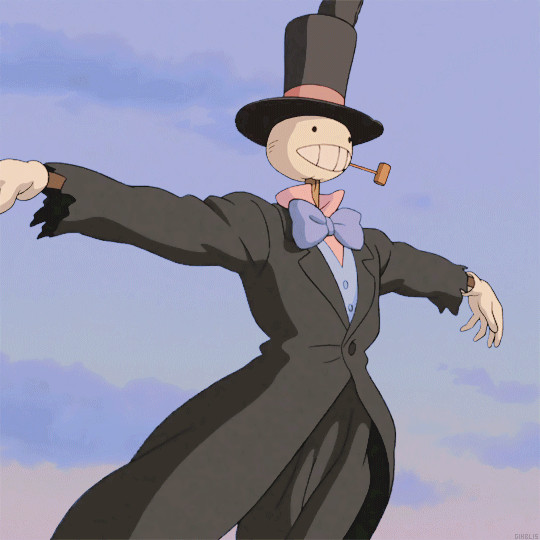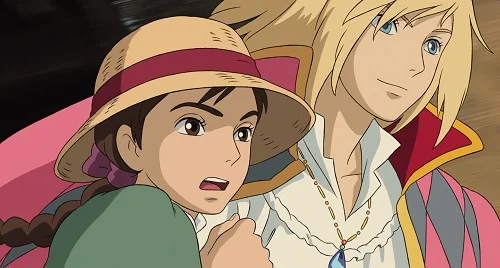Hayao Miyazaki's “HOWL'S MOVING CASTLE”
Movie review by Dennis D. McDonald
What did I like least about this film? The answer: the ending. It is too pat, too rushed, too abrupt.
What do I like most? Just about everything else. In fact, I found myself smiling at what I was seeing on the screen more often than in any movie I’ve seen since The Incredibles — and that is saying a lot.
I like Miyazaki’s characters (I am using the name “Miyazaki” to refer to the collective creative forces behind this film at Studio Ghibli, which Miyazaki founded). Not having read the novel this film is based on, I can’t tell how much is Miyazaki and how much is the novel. But there are interesting characters here that attract and hold our attention.
Some are outrageous (Calcifer, Turnip-Head, the Witch of the Waste), some are subtle (Sophie). And some are enigmatic (Howl himself). We don’t necessarily become as drawn to these characters emotionally as we are with Miyazaki’s characters in Nausicaa, Princess Mononoke or Spirited Away, but this is not the same type of movie. It’s a Fairy Tale more in the classic Grimm sense with a healthy sprinkling of Japanese spirit world for good measure.
I like how Miyazaki tells the story and how he keeps our interest. This is most clearly seen when the geographic focus of the story becomes the kitchen area that Old Sophie stumbles upon when first entering the castle. We are gradually introduced to important characters (e.g., Calcifer) and here we learn more about Howl and how the Castle moves through space and time. We spend a lot of time here; it does not become claustrophobic as we and Sophie learn more about her situation and the incredible world we she now finds herself in.
The animation in this film must be seen to be believed. I’ve read other reviews who salute Miyazaki for his adherence to “traditional animation techniques.” I partially agree. There is more use of CGI effects in this movie than may be apparent at first glance. I am referring to the use of what I in my technical ignorance shall call “moving perspective.” As we move through the scene watching our characters, for example, as we walk along a street, objects change in size smoothly as our viewing point shifts.The most obvious example of this in Spirited Away was when Chihiro ran through a path surrounded by flowers. You could tell that the original drawing of the flowers was two dimensional but has been stretched onto a three dimensional surface then rotated and moved to simulate objects moving past a running person’s field of vision.
As CGI effects go this is nowhere near as sophisticated as the water-rendering that Pixar excels in, but that’s not the point. By using two dimensional paintings [“cartoons”] as the manipulated objects, we get some of the “reality” of 3D rendering but still retain the charm of the traditionally drawn and painted object.
Turnip-head
After all, Miyazaki is creating a fantasy world here, a world where witchcraft, magic, and demons co-exist with hat shops, steam engines, automobiles, and flying cars. Too much reality would be too much of a bad thing.
Interestingly, the most realistic effects in this movie are the scenes of warfare when viewed from a distance. The scenes of aerial combat, exploding bombs, and burning cities that provide such an effective backdrop to Sophie’s adventures are grim and horrific and not pitched towards the anime gadget-lover. They’re scary. That’s the idea.
What are the most memorable images in this film? That’s hard to say, there are so many, for example:
Sophie’s flight over the city with Howl
Sophie’s first view of the country from the Castle’s balcony
Sophie crying by the edge of the lake — and Turnip-Head holding an umbrella over her to keep off the rain
The draining of the Witch of the Waste’s powers in the the palace
Watching the “meteor shower” and the distant young Howl
My favorite effect was sometimes the most subtle — Sophie’s changing age as shown in her face. Sometimes it is so subtly doneyou can’t tell for sure if she is younger or older — and that’s the point. (It reminded me of the “young Ellie-Old Ellie” scene in Contact when Jodie Foster’s face is momentarily replaced by her younger self played by Jena Malone.)
I’ll probably be seeing this film again. Perhaps I’ll see the English language version to compare; the theater where I saw Howl was showing the Japanese versions with English subtitles. This is usually the way I prefer to see Japanese films (in Japanese with subtitles) but I’ve heard that the dubbing in the English language version is pretty good.
Young Sophie and Howl
Review copyright (c) 2005 by Dennis D. McDonald


















!["EVANGELION:1.11 YOU ARE (NOT) ALONE" [movie]](https://images.squarespace-cdn.com/content/v1/52fbe871e4b060243dd758d6/1669903001839-HJR22R5MSXAHQW6PMTIH/eva-3.jpg)















